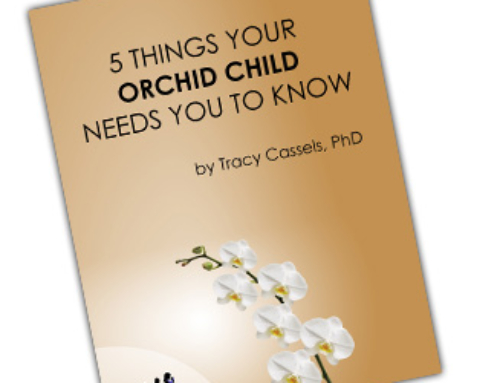
One of the more fascinating things about Orchids is this dual environment in which we find higher proportions of Orchids. What I mean is that, for years, we thought that this hyper-reactivity to stress must have been a result of negative environments. Only such strong reactions to stress could come from something bad, right? As we now know, that’s not right. Orchids are disproportionately found in more negative environments, that’s true, but also more positive environments. Although many of us will simply take this, a question I’ve often had is: How???
Some may jump in with the idea of genetics being at play, but genetics can’t be the whole story. We know that something is rarely ever fully heritable, especially complex behaviours like stress reactivity. Thanks to the emerging field of epigenetics, we have ample evidence that most things that have been thought to be “genetic” do have a genetic component in terms of susceptibility, but that has to interact with specific environments to come about. So with orchids, there is a genetic component (yes, we have identified genes that seem to be associated with it), but this has to interact with the environment.
This environment is where the good and bad come into play. A negative environment is going to elicit stronger stress responses and that alone may explain why the genes get triggered and we see these hyper-alert behaviours, stronger stress responses, and so on that define Orchidness. But what about the positive? How would this work? One would think that the positive environment would dampen the stress response, right?
In a podcast episode with Dr. Kathy Kendall-Tackett, she mentioned some very interesting findings that I hadn’t come across despite being not-so-new. It was driven by Dr. Uvnas-Moberg’s work on oxytocin, which I knew all about with respect to breastfeeding, but this was something else. It was the finding that high levels of oxytocin seem to also be linked to higher levels of social awareness in others. As we know, high social awareness can be linked to higher threat detection, especially in younger children who may see the world as scary and unfamiliar.
In a deeper dive into this, I found some interesting findings that I do believe could explain how this positive environment for Orchids can result in the types of behaviours we see (though of course we need far more research):
- In a neuroimaging study with adults exposed to a fear, empathy, and control condition, the injection of oxytocin resulted in greater activation of the bilateral temporo-parietal junction, the right anterior insula, and left posterior insula in the fear condition only. For reference, the temporo-parietal junction is crucial to our theory of mind (i.e., our ability to discern other people’s thoughts and emotional states) and our ability to integrate information from others and processing it which means that extra activation can make us more sensitive to those around us. The right anterior insula is involved in interoception awareness of homeostatic emotions (i.e., thirst, hunger) which means extra awareness may make these sensations even stronger than they should be. Finally, the posterior insula is linked to pain perception which may explain why orchids can respond so strongly to pain. Remember that these take place during fearful stimuli coupled with oxytocin and for many kids, they have the buffer of the positive parents who support them, often with touch, and this increases oxytocin, but they also are in an environment that may elicit fear which then creates a cycle of stronger reactions.
- Another paper reviewing the research on oxytocin and social behaviours highlights the way in which oxytocin increases social salience of whatever is going on. This means that increased oxytocin – as mentioned by Dr. Kendall-Tackett – makes us more aware of the social cues surrounding us. For many children, this may be overwhelming as they don’t have the ability to process all that is coming in. We know sensory overload is what seems to happen to a lot of Orchids when in overstimulating environments. However, it doesn’t mean it’s all negative as we see in these positive outcomes for Orchids. Children who are in positive environments and have the support of parents are more likely to be able to handle these social cues and integrate them which may explain why these children tend to have better outcomes in the long run. This doesn’t mean Orchids in positive environments don’t meltdown or get overstimulated, but that the support they have allows them to process these events or even have parents who can structure the environment more to reduce the type of overstimulation that can come. Regardless of the outcomes, though, the consistent findings that oxytocin increases social salience seems potentially crucial for how the positive environment can elicit Orchidness.
- Fitting with the above information, one study found that this attention to social cues happened below the threshold of awareness. Looking at pupil dilation to stimuli, those administered oxytocin showed awareness of social cues without actively being able to report on it. When we think about our Orchids’ crazy ability to pick up on social cues, this may be part of what we are seeing (at least in positive environments).
- Another study also looked at our ability to “mind-read” (theory of mind) and the effects of oxytocin and found that the administration of oxytocin increased the ability to read mental and emotional states in others and this was particularly pronounced for more difficult mental states. Again, when we look at how attuned Orchids are to the emotions of others, especially in more positive environments, this may be one of the mechanisms by which this occurs.
- In another review of how oxytocin has its effects on the social systems, research seems to show that oxytocin not only has its own effects, but interacts with other neurotransmitters to affect their behaviours. One of these is the stress system as oxytocin can reduce overall stress, which is likely one of the main reasons as to how that supportive, positive environment results in longer-term positive outcomes for these Orchids. They do get stressed – and partially potentially because of higher levels of oxytocin interacting with a genetic predisposition – but then that support helps buffer the stress which has long-term effects on overall stress reactivity.
These are just a few of the findings out there that seem to suggest there could be a role for oxytocin in not just the development of Orchidness (as it interacts with genetics), but also how it may change the trajectory to elicit these positive outcomes for Orchids in these supportive environments. Some may be wondering about this and I want to highlight here that what we may be seeing is actually less of an effect of too much stress causing more stress, but oxytocin leading to higher levels of awareness which leads to stress (because of overstimulation). The behaviours may look similar, but the underlying biology would be different and would explain the differential outcomes based on the environment. This also means that when you are struggling with your orchid, anything that may increase Oxytocin in a calm and safe environment may be the best thing you can do.
Some Relevant References
Baettig, L., Baeumelt, A., Ernst, J., Boeker, H., Grimm, S., & Richter, A. (2020). The awareness of the scared-context dependent influence of oxytocin on brain function. Brain imaging and behavior, 14(6), 2073-2083.
Bartz, J. A., Zaki, J., Bolger, N., & Ochsner, K. N. (2011). Social effects of oxytocin in humans: context and person matter. Trends in cognitive sciences, 15(7), 301-309.
Domes, G., Heinrichs, M., Michel, A., Berger, C., & Herpertz, S. C. (2007). Oxytocin improves “mind-reading” in humans. Biological psychiatry, 61(6), 731-733.
Uvnas-Moberg, K., & Petersson, M. (2005). Oxytocin, a mediator of anti-stress, well-being, social interaction, growth and healing. Zeitschrift fur Psychosomatische Medizin und Psychotherapie, 51(1), 57-80.
Uvnäs-Moberg, K. (1998). Oxytocin may mediate the benefits of positive social interaction and emotions. Psychoneuroendocrinology, 23(8), 819-835.
Xue, S. W., Wu, H. B., Zhang, L., & Zhang, D. X. (2020). Intranasal oxytocin increases perceptual salience of faces in the absence of awareness. Psychiatry investigation, 17(4), 292.
Schulze, L., Lischke, A., Greif, J., Herpertz, S. C., Heinrichs, M., & Domes, G. (2011). Oxytocin increases recognition of masked emotional faces. Psychoneuroendocrinology, 36(9), 1378-1382.



Leave A Comment